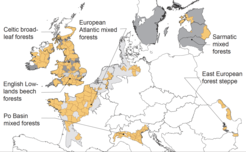Closing the gaps in Europe’s nature protection network
The Offspring declared August as "Sustainability & Environmental" Awareness Month. We are starting off with a contribution by Anke Müller, a doctoral researcher from the MPI for Meteorology, Hamburg. She is writing about why she focused her studies on nature conservation & biodiversity and about the evaluation of European Union`s nature protection network Natura 2000. For more about this you can follow Anke on Twitter @SimplyAnke
by Anke Müller
When I woke up in the morning, the first thing I would see from my window was the North Sea, sometimes grey with rough waves, sometimes bluish green contrasting a blue sky, sometimes retracted, leaving behind the bare soil and hundreds of birds busily fishing and picking their breakfast. It was the summer after I finished high school and I spent several months as an intern of a nature protection association at the island of Langeneß. My days were filled with monitoring breeding birds, taking care of the cows that were part of a grazing intensity experiment and guiding school classes and tourists. I showed them the Wadden Sea, this unique intertidal ecosystem that is both land and sea, and the salt marshes with their spectacular winged inhabitants and beautiful, salt-tolerating flowers. Ever since my stay there, I only experience a true feeling of belonging, of pure joy or happiness, when being out in nature, in landscapes and ecosystems which are not yet fully dominated and shaped by human interventions.
Not surprisingly, I decided to study landscape planning and nature conservation afterwards. Many times during the years of my study, I would have the pleasure of wandering through natural or traditionally farmed landscapes and observing the diverse plant and animal species that have adapted to each of these specific environments. However, I also learnt about all the threats that human overconsumption and excessive resource use put on this magnificent web of life, or biodiversity, as we call the diversity of all existing life forms from genes to plant and animal species to ecosystems. Having entered the Anthropocene, humanity has become the dominant force in shaping the biosphere and we have converted large parts of natural habitats into production lands inhospitable to the species that used to live there. We have hunted many animal species beyond sustainable limits, have poisoned them with pesticides, polluted their habitats with oil, heavy metals or plastics and lately, we are changing climatic conditions at a pace that animal and plant life cannot keep up with. There seems to be no limit to the cruelty humanity is willing to commit against the fellow species that have co-inhabited this planet for millennia. In the name of progress and for the sake of economic growth we accept ever accelerating levels of nature destruction.
Realizing the damage done and the alarming rate with which species were and still are driven towards extinction, more than a hundred nations pledged to stop biodiversity loss by signing the Convention on Biological Diversity (CBD) back in 1992. Since then, further reports such as the Millennium Ecosystem Assessment (2005) have visualized the crucial link between human well-being and the functioning of healthy ecosystems. However, as the first global assessment of the Intergovernmental Science-Policy Platform on Biodiversity and Ecosystem Services (IPBES, 2019) has recently shown, process towards solving the biodiversity crisis has been limited and the problem has rather become more severe over the last few decades, with a staggering one million species currently on the brink of extinction. Witnessing how we as global, national and local societies fail to safeguard the very foundations our cultural, economic and societal systems are built upon, I aimed for a PhD topic that would investigate how we could improve biodiversity protection in the future. This is what I now work on, as part of the research area ‘human dimensions’ at the International Max Planck Research School on Earth System Modelling in Hamburg.
One important action to mitigate the loss of biodiversity is the establishment of nature protection networks. In these connected protected nature reserves, it is possible to ban most direct drivers of species extinction, such as habitat destruction or overexploitation. This is why the CBD’s current strategic plan on biodiversity, which consists of 20 so-called Aichi targets, is calling for the formal protection of 17% of the terrestrial area of the planet (one objective of Aichi target 11). Since this strategy was adopted in 2010, there has been quite some progress towards this target in different parts of the world. Still, species keep drifting towards extinction despite the growing number of protected areas. We can understand this seeming paradox if we look at the different factors that determine the effectiveness of protected area networks. To safeguard biodiversity, it is not sufficient to just put a certain area under legal protection. Instead, a strategic placement and adequate management of protected areas is necessary to ensure that all components of biodiversity will be able to thrive in the future.
For my PhD project, I decided to evaluate the European Union’s nature protection network Natura 2000. The Natura 2000 network is one of the world’s largest nature protection networks under a single regulatory framework. It already covers more than 18% of the EU’s land area, surpassing the 17% target the CBD has called for. Therefore, the member states currently consider the designation process of protected areas in the terrestrial part of the network as complete. Nevertheless, biodiversity loss on the European continent is still ongoing, with more than 22% of the 11,260 European plant and animal species assessed to date by the IUCN Red List classified as threatened. There are many reasons for this ongoing loss of biodiversity despite the efforts already made, but for my research, I focus on the question whether the European Union’s protection network is covering biodiversity adequately.
Previous work on the evaluation of Natura 2000 has mainly focused on the coverage of certain vertebrate species groups such as amphibians, mammals or birds. The problem with evaluation on species level is that there are so many of them: It is not possible to monitor them all in sufficient detail, which causes huge data gaps. Instead of resorting to the evaluation of just another sub-sample of species for which data are available, I decided to look at coarser classifications of biodiversity that can be monitored much easier, namely habitat types and ecoregions. In the EU, there are more than 230 habitat types for which Natura 2000 sites should be designated, i.e. Luzulo-Fagetum beech forests, Mountain hay meadows or Sea dunes of the Mediterranean coast. Ecoregions, on the other hand, are a set of relatively broad, but ecologically distinct regions of which we have about forty in the European Union. Some of them cover only a part of a member state’s area, such as the Po Basin mixed forests, which is located in Northern Italy. Others, such as European Atlantic mixed forests have a much larger extent, ranging from the Danish west coast down to the Pyrenees. Despite their names, ecoregions in the EU do not only consist of forest habitat types but within one ecoregion a mosaic of different habitat types can be found. Each of these habitat types in each of the ecoregions harbors unique plant and animal communities. However, how much of each ecoregion does the protection network actually need to protect in order to “adequately” cover biodiversity in that ecoregion?

Credits: Beniamino Abis/Philipp Hoß
This question is also dealt with by the technical rationale document to Aichi target 11. According to this guideline, a protection reserve network needs to cover 10% of each ecoregion to be considered “ecologically representative”, which is another objective of Aichi target 11. I evaluated the Natura 2000 network against this coverage target to monitor the EU’s progress towards this specific objective of Aichi target 11. In my analysis, however, I found that the Natura 2000 network, even though it is one of the largest nature protection networks worldwide, still does not fully cover six of the about forty ecoregions (Figure 2, see map below). Even though the EU has formally declared the designation process of Natura 2000 sites to be finished, my results suggest that additional nature reserves should be added to the protection network in those six gap ecoregions in order to fulfill Aichi target 11 of the CBD.
But where should such additional nature reserves be best placed? Most suitable candidate sites would not only close the coverage gap of an ecoregion. To increase coverage of diverse biodiversity components in the network even further candidate sites should be selected for those habitat types within an ecoregion that are currently least protected by existing reserves. Additionally, conservation always has to deal with scarce monetary resources, so it is important to identify the cheapest regions, i.e. regions with lowest land costs, where conservation objectives can be fulfilled.
To simulate such a systematic and cost-efficient expansion of the Natura 2000 network, I developed and programmed an optimization computer model. With this model, I determine the cheapest set of European regions where additional conservation area could be allocated to cover 10% of each ecoregion and at the same time increase the protection of habitat types that are not yet well covered by the existing protection network. My results show that eleven member states would need to expand their national Natura 2000 networks to close the six gapped ecoregions’ protection shortcomings (Figure 2). This would translate into adding in total roughly 15,000 km² or 0.35% of the EU’s land area to the nature reserve network (Müller, Schneider, & Jantke, 2018). For example, to fully cover the ecoregion European Atlantic mixed forests, some additional Natura 2000 sites should also be designated in North German counties around Hamburg. Here, especially peatland forests could be targeted habitat types for future protected area designations.

For biodiversity protection, 2020 will be a year of great importance, because the CBD’s current strategic plan on biodiversity will expire by then. Nations have to come up with a new biodiversity protection plan at the 15th Conference of the parties (COP 15) of the CBD, which will take place in October 2020 in Beijing, China. Similar to the Paris Agreement for Climate Change, progress towards solving the biodiversity crisis will largely depend on the level of ambition signatory parties agree upon. The framework they decide on will determine whether we will be able to reverse the current trend of biodiversity decline. Will we safeguard these one million species currently most threatened or will we lose them forever? Scientific contributions such as my PhD thesis are important to track progress towards the targets of current biodiversity strategies and highlight where future actions should be directed at. The scientific community already provides a very detailed description of the problem and has described in many cases the solutions to tackle it. However, it is now upon us as societies to decide if we seriously want to keep the web of life on this planet functioning and thus demand of policy makers to go ahead and implement these solutions.
Further reading:
IPBES. (2019). Global assessment report on biodiversity and ecosystem services of the Intergovernmental Science- Policy Platform on Biodiversity and Ecosystem Services. Retrieved from Bonn, Germany: https://www.ipbes.net/global-assessment-report-biodiversity-ecosystem-services
Millennium Ecosystem Assessment. (2005). Ecosystems and Human Well-being: Synthesis. Washington, DC: Island Press: https://www.millenniumassessment.org/en/index.html
Müller, A., Schneider, U. A., & Jantke, K. (2018). Is large good enough? Evaluating and improving representation of ecoregions and habitat types in the European Union's protected area network Natura 2000. Biological Conservation, 227, 292-300. doi:https://doi.org/10.1016/j.biocon.2018.09.024













